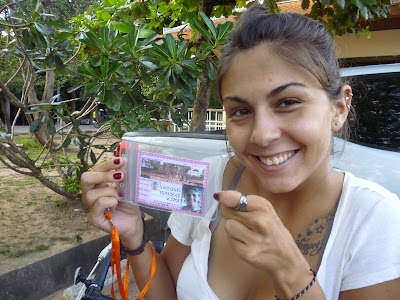Como sabéis hace unos días ha sido el cumpleaños de Andrea,
y lo hemos celebrado a lo grande. Primero, porque cumplía un cuarto de siglo
(el primero de muchos). Y segundo, porque ha sido su primer cumpleaños sin
frío.
Os lo contamos en cinco pasos.
1- Cenar en un restaurante de Corea del Norte. Esta ha sido
una de las experiencias más bizarras de nuestro viaje, por el personal, el
espectáculo y la comida. Las personas que trabajan en estos restaurantes son
casi las únicas que salen de su país. Como visitar Corea del Norte es difícil y
caro, esta es una de las raras ocasiones en las que es posible interactuar con
norcorean@s.
Nuestra camarera, muy amable, participaba junto con las
otras en el espectáculo. El show se compone de música en directo, danza que
suponemos será tradicional (aunque vimos castañuelas), y trajes muy llamativos.
Duró aproximadamente una hora y nos dejó con la boca abierta.
 |
| Ummmm, rico perrooooo |
La comida también es especial. El plato estrella: perro
guisado. Como eran trozos de carne podían haber sido de ternera (estaban muy
tiernos), y el guiso estaba bueno. Lo acompañamos con noodles fríos, tortitas
de calabaza y ternera salteada con verduras. De beber, soju, el licor típico.
A pesar de ser un poco caro (pagamos 10€ por persona),
merece la pena adentrarse en el extraño
universo de Corea del Norte.
2- Tratamiento en un spa. Si algo hay en el Sudeste Asiático
son masajes a precios de ganga. Por menos de 5€ cada un@ nos dimos un masaje
tradicional de hora y cuarto en un elegante spa con música relajante y perfumes
florales. Además, la cumpleañera se hizo una manicura y pedicura por unos 4€
(lo acompañan de un breve masaje).
3- Comer en el restaurante de la ONG Friends (Child Safe). Este
restaurante tiene como objetivo proporcionar a jóvenes desfavorecid@s una formación
en el mundo de la hostelería. También tiene otros proyectos como salones de
belleza e incluso una tienda con objetos realizados a partir de materiales
reutilizados. El menú está compuesto por tapas creativas que rondan los 3€. Comimos
estupendamente por una buena causa, que más se puede pedir.
4- De postre, tarta. Como el cumpleaños de Talia fue dos días
antes, los chicos se encargaron de sorprendernos con una rica tarta y velas de
las que no se apagan.
5- Darse un chapuzón. Este año he tenido un cumpleaños muy
especial pues ha sido el primero en toda mi vida en el que he pasado calor. Tanto,
que nos fuimos a la piscina.
Todo esto ha sido posible gracias a Alvaro, que siempre sabe
cómo hacerme sonreír.
Like you
already know it's been Andrea’s birthday a few days ago, and we have celebrated it in a big way. First,
because she became a quarter of a century old (the first of many). And
secondly, because it has been her first birthday without cold.
We will
tell you about it in five steps.
1- Having
dinner in a North Korean restaurant. This has been one of the weirdest
experiences of our journey, due to the personnel, the show and the food. The
people who work in these restaurants are one of the few that ever leave their
country. Because visiting North Korea is difficult and expensive, this is one
of the rare occasions in which it is possible to interact with North Korean
people.
Our
waitress, very kind, participated together with the others in the show. The
show is a mixture of live music, dances which we suppose are traditional (even
if we saw castanets), and very gaudy dresses. It lasted for about an hour and
it was jaw-dropping.
The food is
also special. The star dish: dog broth. We ate pieces of meat so it could have
been beef (they were very tender), and the broth was good. We accompanied it
with cold noodles, pumpkin pancakes and stir fried beef with vegetables. For
drink, soju, the typical liquor.
Despite
being a bit pricey (we paid ten euros per person), the experience of entering
in North Korea’s weird universe is worth it.
2-
Treatment in a spa. If there is something you can find everywhere in South East
Asia is a cheap massage. For less than five euros each we enjoyed 75 minutes of
massage in an elegant spa with relaxing music and floral fragrances. Moreover,
the birthday girl had a manicure and a pedicure done for around four euros
(accompanied with a short massage).
3- Eating
in NGO Friends’s (Child Safe) restaurant. This restaurant has as its main goal
to provide jobs for disadvantaged youths in the hospitality sector. It also has
other projects such as beauty salons and a shop with articles made out of reused
materials. The menu is made out of creative tapas that cost around three euros.
We had a fantastic meal for a good cause, what else can you ask for?
4- For
dessert, a cake. Because Talia’s birthday was two days before, the guys decided
to surprise us with nice cake and candles that don’t blow out.
5- Go
swimming. This year I’ve had a very special birthday because it has been the
first one in my whole life in which the weather has been hot. So hot, that we
went to a swimming pool.
All of this
has been possible thanks to Alvaro, he always knows how to make me smile.







































